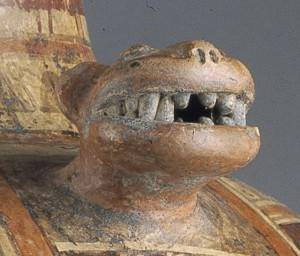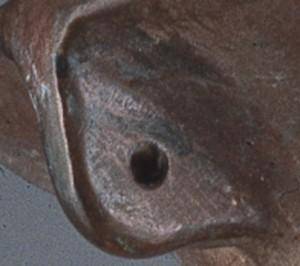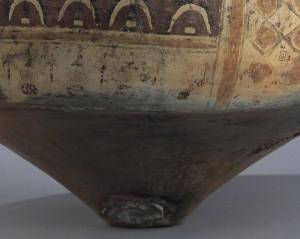Students will examine the artistic characteristics of the Inca Large Jug, describe the kind of ceremonial, festive occasion in which the jug may have been used, and compare and contrast large celebrations in the ancient Inca Empire with those in modern-day American cultures.
Students will be able to:
- examine the artistic characteristics of the Inca Large Jug;
- locate Peru on a map of the world;
- describe the kind of ceremonial, festive occasion in which the Inca Large Jug may have been used; and
- compare and contrast large celebrations in the ancient Inca Empire with those in modern-day American cultures
Lesson
- Warm-up: Display or pass out copies of the Inca Large Jug and invite students to look carefully and share what they observe. What do they notice? How would they describe the shape of the jug? What colors appear on the jug? What materials were used to make the jug? What symbols or figures appear on the jug? What adjectives would they use to describe the jug? What purpose or function might the jug have served?
- Give students a better idea of the size of the Inca Large Jug, which measures 30 inches in height and 21.5 inches in diameter. Have a couple of volunteers measure those dimensions in front of the class. Is there an object in the classroom that has similar dimensions?
- Share with students that the jug, or aryballo [AIR-ee-BALL-oh], was created in Peru between A.D. 1400 and 1532. Have students locate Peru on a world map. Share some quick facts about Peru (e.g., geography, climate, languages, natural resources, government, history) by distributing or displaying information from appropriate websites such as The World Factbook.
- Explain to the students that commoners in the Inca Empire paid tribute to their local lords, religious authorities, and imperial administrators in the form of labor and military service. These authorities reciprocated with food, clothing, and other necessities. They also held feasts for their tributaries, providing copious amounts of chicha, a type of beer made from corn. Very large vessels like this aryballo would have been used during these festive, ceremonial occasions. Serving chicha from an elaborately decorated aryballo like this one emphasized the wealth and generosity of the Inca state. Refer to the About the Art sheet for more information.
- Ask students to think about the kinds of celebrations that bring together large numbers of people in modern-day United States society. What are the reasons for holding these large celebrations? Who hosts and who attends these celebrations? What kinds of gifts might be given? What kind of food and drink is served? How often are these celebrations held?
- Encourage students to create a Venn diagram or write a short essay comparing and contrasting large celebrations in both societies/ civilizations. How are large celebrations in the Inca Empire similar to and different from large celebrations in the modern-day United States of America?
- When students are finished, invite them to share their ideas and display their creations in the classroom.
Materials
- Lined or blank paper for each student
- Pens, pencils, or colored markers
- Map of the world, visible to all students in the classroom
- Internet access to websites for facts about Peru, such as The World Factbook
- Copies of About the Art sheet on Inca Large Jug (found at the end of the lesson plan) or student access to this part of Creativity Resource online
- One color copy of the Inca Large Jug for every four students, or the ability to project the image onto a wall or screen
Standards
- Social Studies
- Critical Thinking & Reasoning
- Information Literacy
- Invention
- Self-Direction
Urpu with Insect Design
We don’t know who crafted this jug, but because of its shape, we know that the artist lived during the time of the Inca Empire. Vessels such as these were made in both large and small sizes. The artist formed the jug out of clay, smoothed the surface, and then decorated it with colored slips that were made up of a mixture of clay, water, and mineral pigments. Finally, the surface of the vessel was burnished or polished before firing.
Ceramics made by craftsmen in the workshops of Cuzco, the Inca capital, were highly prized as tangible evidence of imperial prestige. Local imitations were produced throughout the vast territory conquered by the Inca, which extended from Ecuador in the north to Chile in the south. Numerous ethnic groups and independent political entities were not only conquered but also effectively integrated into a centrally administered political and economic system.
Vessels of this shape were used to hold liquids, especially chicha, a kind of beer made from corn. Very large vessels like this one would probably have been used on festive, ceremonial occasions. In the Inca Empire, commoners paid tribute to their local lords, religious authorities, and imperial administrators in the form of labor and military service. These authorities reciprocated with food, clothing, and other necessities. Most importantly, leaders held feasts for their tributaries, providing copious amounts of chicha. Serving this beer from an elaborately decorated jar such as this emphasized the wealth and generosity of the Inca state. Inca vessels of this shape are called aryballos because of their resemblance to similarly shaped ancient Greek ceramics.
Details

Painted Decorations
The painted decorations on this vessel are particularly elaborate. Red and black flamingos form lines around the neck. The front of the vessel is divided into three zones: a vertical central panel with a diaper pattern (an all-over diamond-shaped pattern) that is flanked by two horizontally subdivided sections filled with insects and flowers.

The Lug
The lug, found on the vessel’s shoulder at the base of the neck, is shaped like a jaguar head with a toothy mouth.

Ingenious Design
The handles and lug, along with a strap, were used to transport the jug. The strap was looped through one handle, up over the top of the lug, and then down through the other handle. The person carrying the jug used his back for support and tied the two free ends of the strap around his waist.

Holes at the Rim
There are two small holes under the rim of the vessel that would have been used to secure a lid (now missing).

Pointed Base
The pointed base was intended to be set in a depression in a dirt floor.
Funding for object education resources provided by a grant from the Morgridge Family Foundation. Additional funding provided by the William Randolph Hearst Endowment for Education Programs, and Xcel Energy Foundation. We thank our colleagues at the University of Denver Morgridge College of Education.
The images on this page are intended for classroom use only and may not be reproduced for other reasons without the permission of the Denver Art Museum. This object may not currently be on display at the museum.







